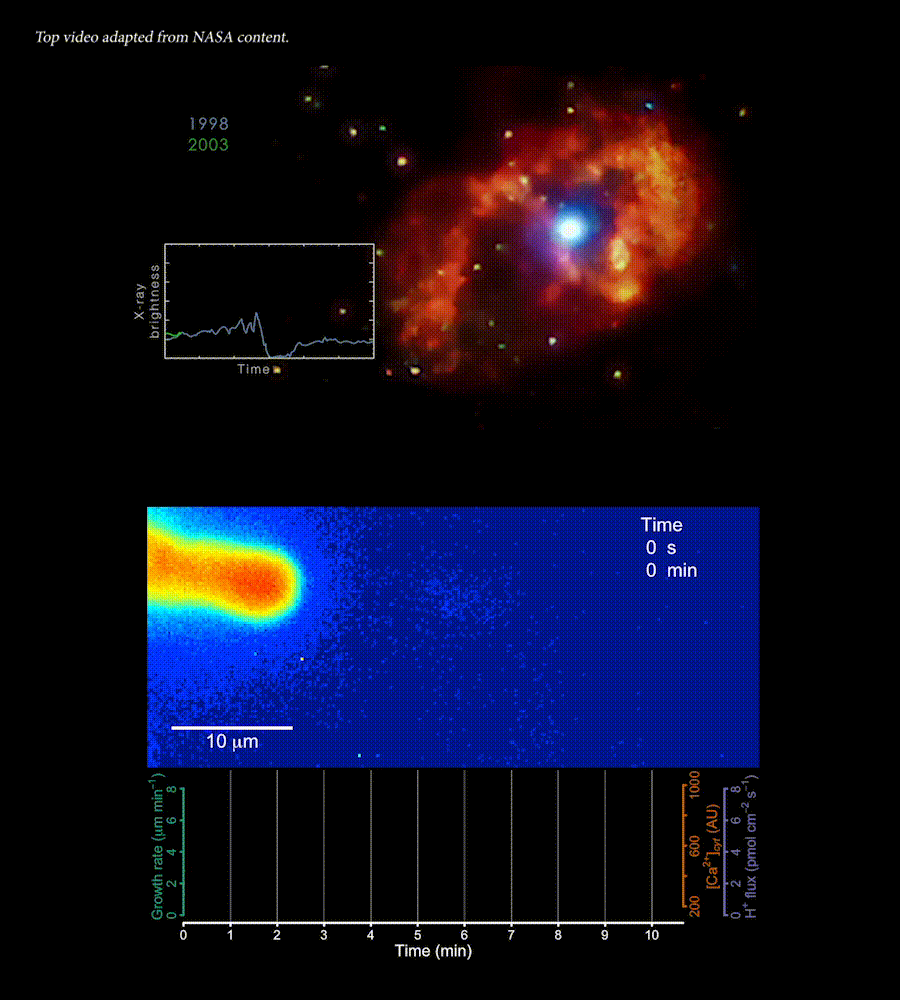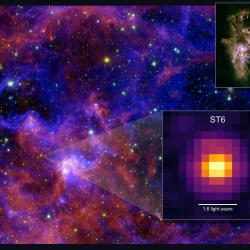Discovering Hidden Rhythms in Space with CHUKNORRIS
You might not think that a distant star system would share any similarities with a flower’s reproductive organ. But as new research shows, both structures exhibit internal rhythms, according to University of Maryland researcher Daniel Damineli.
Damineli, a postdoctoral researcher in the laboratory of Cell Biology and Molecular Genetics (CBMG) Professor José Feijó, developed a software package called CHUKNORRIS (Computational Heuristics for Understanding Kymographs and aNalysis of Oscillations Relying on Regression and Improved Statistics). He designed this software to study biological rhythms in growing pollen tubes, which carry the sperm cells of flowering plants. In March 2017, Damineli, Feijó and former CBMG postdoctoral researcher Maria Portes published their study, with results obtained using CHUKNORRIS, in the Journal of Experimental Botany.
It turns out that CHUKNORRIS also works on astrophysical rhythms. In 2018, Damineli teamed up with his father—Brazilian astronomer Augusto Damineli from the University of São Paulo in Brazil—to analyze Eta Carinae, a stellar object that pulses about every five and a half years.
Eta Carinae was first observed in the 17th century. In 1996, Augusto Damineli was the first to propose that Eta Carinae is a binary star system that appears to pulse because of the specific manner in which the two stars orbit each other. In 2019, the father and son team participated in an international study on Eta Carinae and used CHUKNORRIS to analyze the system’s pulsing behavior.
The Daminelis’ results, published in the journal Monthly Notices of the Royal Astronomical Society in January 2019, showed that Eta Carinae has two additional, previously unknown pulses: one faster and one slower than the pulse that Augusto Damineli found. Scientists do not yet know what is generating these two beats. There may be even more hidden rhythms; both Daminelis are currently investigating this together.
“I have heard my father talking about the stars for as long as I could understand language,” Daniel Damineli said. “When I was younger, I would sleep by the telescope and steal his late-night snacks. Later on, he paid me to enter data on Eta Carinae. But I never thought that I would get the chance to collaborate with him directly. Having published this paper with my father is a huge honor.”
Top: Eta Carinae (right) is star system whose brightness pulses (left) with a period of approximately 5.6 years. Video adapted from NASA content.
Middle: A time-lapse visualization shows a pollen tube's growth in a span of ten minutes. Redder colors correspond to higher concentrations of calcium ions, which regulate cell growth.
Bottom: CHUKNORRIS tracks the pollen tube’s growth (green), calcium ions (orange) and protons (purple), which also help regulate pollen tube growth. All three measurements follow the same rhythmic “beat” as the pollen tube grows.
###
The research paper, “Distinguishing circumstellar from stellar photometric variability in Eta Carinae,” Augusto Damineli et al., was published in the journal Monthly Notices of the Royal Astronomical Society on January 14, 2019.
This work was supported by the National Council for Scientific and Technological Development, Fundação de Amparo à Pesquisa do Estado de São Paulo, NASA, and the National Science Foundation (Award Nos. AST-1311993 and MCB 1616437/2016). The content of this article does not necessarily reflect the views of the organizations.
The research paper, “Oscillatory signatures underlie growth regimes in Arabidopsis pollen tubes: computational methods to estimate tip location, periodicity, and synchronization in growing cells,” Daniel Damineli, Maria Portes and José Feijó was published in the Journal of Experimental Botany on March 28, 2017.
This research was supported by the National Science Foundation (Award No. MCB 1616437/2016). The content of this article does not necessarily reflect the views of the organization.
Media Relations Contact: Irene Ying, 301-405-5204, zying@umd.edu
University of Maryland
College of Computer, Mathematical, and Natural Sciences
2300 Symons Hall
College Park, MD 20742
www.cmns.umd.edu
@UMDscience
About the College of Computer, Mathematical, and Natural Sciences
The College of Computer, Mathematical, and Natural Sciences at the University of Maryland educates more than 9,000 future scientific leaders in its undergraduate and graduate programs each year. The college’s 10 departments and more than a dozen interdisciplinary research centers foster scientific discovery with annual sponsored research funding exceeding $175 million.








